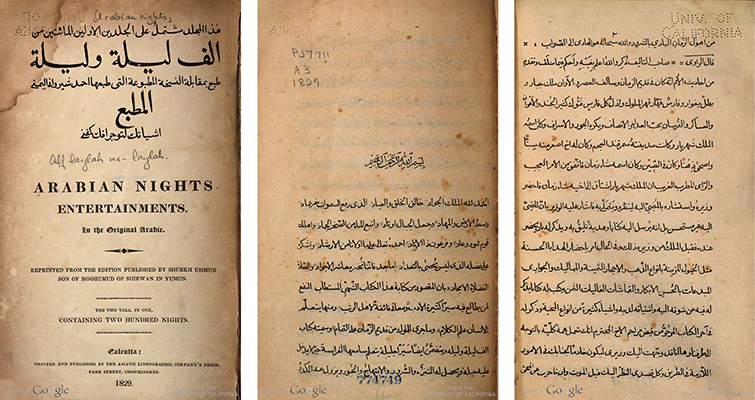33 Arabic

Arabian Nights or One Thousand and One Nights (Arabic: ألف ليلة وليلة, Alf Laylah wa-Laylah) is a multicultural collection of stories. According to The Arabian Nights Encyclopedia, “No other work of fiction of non-Western origin has had a greater impact on Western culture than the Arabian Nights.”1 “[P]reserved in its Arabic compilation, the collection is rooted in a Persian prototype that existed before the ninth century CE, and some of its stories may date back even further to the Mesopotamian, ancient Indian, or ancient Egyptian cultures.”2 This classic, like numerous other Arabic works, reveals the great influence of the Arabic legacy on other cultures.
The first Arabic manuscript of Arabian Nights dates back to the 15th century, which was first translated into French in 1704 by the French orientalist François Galland, followed by the English edition in 1706. Since then, Arabian Nights has been translated and reproduced in numerous languages and formats. Stories from Arabian Nights have also been represented in other art forms, such as drama and films to mention a few. Aladdin, The Thief of Bagdad, and Adventures of Sinbad are three examples of famous films.
Arabic became an essential language for human knowledge in the medieval centuries during the bright period of the Islamic civilization, when Muslim scholars vastly contributed to knowledge and science in many fields: algebra, geography, medicine, social sciences, astronomy and many more.3 The impact of the Arabic language and Muslim scholars’ contribution is seen until today in different disciplines and, most definitely, in languages worldwide. In English, for instance, algebra, chemistry, and algorithm are originally Arabic words.
As the native language in more than 20 Arab nations and one of the official languages in many other countries, Arabic is one of the most spoken languages in the world after Chinese, Spanish, and English; hence, it is one of the six languages recognized by the United Nations. Arabic is one of the Semitic languages which, like Hebrew, are written from right to left. Most importantly, Arabic is the language of the Quran, the holy book of Islam. Therefore, it is the language of daily prayers around the world regardless of the Muslims’ native languages.
According to the Modern Language Association’s enrollment data for 2016, Arabic is among the top 10 languages taught in the US with 31,554 enrollments in 2016 compared to 24,010 enrollments in 2006.4 This number includes students enrolled in classes for standard Arabic, as well as the Arabic language classes focusing on various dialects such as Egyptian colloquial Arabic, Shami (Syrian, Lebanese, and Palestinian/Jordanian) colloquial Arabic, Moroccan and North African colloquial Arabic, and Khaliji Arabic in the Persian Gulf Region.
At UC Berkeley, Arabic is one of the languages of emphasis for the major in Near Eastern Languages and Literature offered by the Department of Near Eastern Studies (NES). Students who major and minor in Arabic learn about the peoples, cultures, and histories of the Arabic speaking world besides the language. NES offers all levels of Arabic language courses: 1A and 1B (elementary), 20A, 20B and 30 (intermediate), and 100A and 100B (advanced), and an intensive summer program. Upper division courses range from the study of colloquial Arabic, to classical prose and poetry, to historical, religious and philosophical texts, to survey of and seminars in both classical and modern Arabic literature.5
Contribution by Mohamed Hamed
Middle Eastern & Near Eastern Studies Librarian, Doe Library
Sources consulted:
- Leeuwen, R. van, Marzolph, U., & Wassouf, H. (2004). Introduction. In The Arabian Nights Encyclopedia (p. xxiii). Santa Barbara, CA: ABC-CLIO.
- Ibid.
- Ignacio Ferrando. ‘History of Arabic’ in Encyclopedia of Arabic Language and Linguistics. Ed. Lutz Edzard et al. Brill Reference Online, 2019. (accessed 9/27/19)
- Modern Language Association of America. Enrollments in Languages Other Than English in United States Institutions of Higher Education, Summer 2016 and Fall 2016: Final Report (June 2019). (accessed 9/27/19)
- Arabic (ARABIC) – Berkeley Academic Guide (accessed 9/27/19)
Title in English: Arabian Nights
Author: unknown
Imprint: Calcutta : The Asiatic Lithographic Company, 1829.
Edition: n/a
Language: Arabic
Language Family: Central Semitic
Source: HathiTrust Digital Library (UC Berkeley)
URL: https://hdl.handle.net/2027/uc1.b000956319

